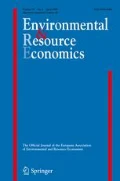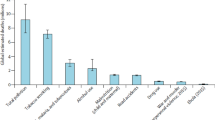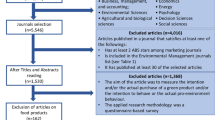Abstract
We incorporate amenity benefits into an overlapping generations model with a renewable resource as a factor of production, source of amenity benefits and store of value. Unlike the conventional renewable resource problems studied under the assumption of additive consumption and amenity benefits, we let amenity benefits affect the utility of consumers in a nonseparable fashion. We examine the role that weights given to consumption and amenities have for harvesting and the resource stock. We characterize dynamics and stability of steady state equilibria with a logistic resource growth function. We demonstrate in parametric and numerical models that the weights given to consumption and amenities in the utility function matter substantially for the steady state equilibrium stock and its stability and dynamics. Both conventional saddle point equilibria and indeterminacy with infinite number of equilibria and saddle-node bifurcation is possible depending on the weights given to consumption and amenities. In addition, we show that for each inefficient equilibrium stock, there is a unique subsidy rate that can move the economy from an inefficient equilibrium to an efficient one. The presence of indeterminacy provides a challenge to resource policies, because the system becomes unpredictable. Therefore, expectations and market psychology may play an important role in resource utilization and provision of amenities.




Similar content being viewed by others
Notes
There are only a few exceptions where environmental goods and consumption are examined using nonseparable preferences. Bockstael and McConnel (1993) study the implications of nonseparablility for environmental valuation but resource use is not studied. Carbone and Smith (2008) examine the choice of environmental taxes when amenities in the form of air quality enter utility in a non-separable way. Carbone and Smith (2013) examine the demand for environmental quality when ecosystem services contribute to utility in a non-separable way. Both of these papers have a static framework. Kim (2002) demonstrates that environmental taxes typically exacerbate pre-existing tax distortions with nonseparable preferences. In this literature, the role of natural resource capital is not made explicit, however. An example of non-separability in dynamic, non-environmental setting is, for instance, the one sector growth model by Shi (1994).
The majority of the Finnish forest landowners produces timber and other forest amenities by choosing ecologically suitable management regimes to promote recreation berry picking, hunting, nature protection and aesthetic values, as shown for instance in Kuuluvainen et al. (1996), and Karppinen (2000). Also, almost all the landowners have adopted voluntary certification of their forests with a special emphasis on forest landscape and forest-related biodiversity conservation. Two recent surveys of empirical analyses of nonindustrial forest landowner behavior by Amacher et al. (2003) and Beach et al. (2005), also show that landowner preferences for nontimber forest benefits have historically been a critical factor in harvesting decisions.
Koskela et al. (2002) study an OG model with a renewable resource, but amenity benefits to consumers from the stored resource are not assumed to be present.
The marginal return of the resource, \({g}'\), depends on the level of the stock. This reflects the fact that a renewable resource, like fish stocks, differs markedly from a conventional asset, whose return in a competitive environment is independent of the amount invested.
The logistic growth curve is a standard specification of growth in resource economics literature; see e.g. a survey by Brown (2000).
The derivation of (12) is rather tedious. We produce the necessary steps in “Appendix”.
It can be seen from (9) above that the first period consumption in a steady state is nonnegative, if \((1-\alpha )h-\alpha x\ge 0\). With logistic growth this means that \(a-(1/2)bx-\alpha (1+a-(1/2)bx)\ge 0\).
Galor (2007) is a source for a two-dimensional dynamics in economics. In particular, for our analysis we have relied on his Figure 3.19.
Note that if \({\upalpha } = 0.2\), the steady-state stock reduces dramatically and locates between 190 and 320 cubic meters depending on the value of \({\upgamma }\). Thus, all equilibria locate to the left of the MSY point.
For details see Galor (2007) p. 88–90, and especially his Fig. 3.19.
Note that when \({\upalpha }= 0.05\) the equilibrium is always a sink (proof available from the authors).
References
Amacher G, Koskela E, Ollikainen M (2002) Optimal forest policies in an overlapping generations economy with timber and money bequests. J Environ Econ Manag 44:346–369
Amacher G, Conway C, Sullivan J (2003) Econometric analyses of nonindustrial forest landowners: is there anything left to study? J For Econ 9:137–164
Amacher G, Ollikainen M, Koskela E (2009) The economics of forest resources. MIT Press, Cambridge
Azariadis C (1993) Intertemporal macroeconomics. Blackwell Publishers, Oxford
Beach RH, Pattanayak SK, Yang JC, Murray BC, Abt RC (2005) Econometric studies of non-industrial private forest management: a review and synthesis. For Policy Econ 7:261–281
Bennett RL, Farmer REA (2000) Indeterminacy with non-separable utility. J Econ Theory 93:118–143
Bockstael N, McConnel K (1993) Public goods as characteristics of non-market commodities. Econ J 103:1244–1257
Brown GM (2000) Renewable natural resource management and use without markets. J Econ Lit 38:875–914
Carbone J, Smith VK (2008) Evaluating policy interventions with general equilibrium externalities. J Public Econ 92:1254–1274
Carbone J, Smith VK (2013) Valuing nature in a general equilibrium. J Environ Econ Manag 66:72–89
Cass D (1972) On capital overaccumulation in the aggregative, neoclassical model of economic growth: a complete characterization. J Econ Theory 4(1972):200–223
Forest Stewardship Council (2012) Facts and figures. https://us.fsc.org/en-us/what-we-do/facts-figures
Forest Stewardship Council (2016) Facts and figures. https://us.fsc.org/en-us/what-we-do/facts-figures
Galor O (2007) Discrete dynamical systems. Springer, Heidelberg
Karppinen H (2000) Forest values and the objectives of forest ownership. The Finnish Forest Research Institute, Research Reports No 757
Kehoe TJ, Levine DK (1990) The economics of indeterminacy in overlapping generations models. J Public Econ 42:219–243
Kemp M, Van Long N (1979) The under-exploitation of natural resources: a model with overlapping generations. Econ Rec 55:214–221
Kim S (2002) Optimal environmental regulation in the presence of other taxes: the role of non-separable preferences and technology. Contrib Econ Analy Policy 1:1–25
Koskela E, Ollikainen M, Puhakka M (2002) Renewable resources in an overlapping generations economy without capital. J Environ Econ Manag 43:497–517
Koskela E, Ollikainen M, Puhakka M (2008) Saddles and bifurcations in an overlapping generations economy with a renewable resource. Finn Econ Pap 21:3–21
Krautkraemer JA (1985) Optimal growth, resource amenities and the preservation of natural environments. Rev Econ Stud 52:153–170
Kurz M (1968) Optimal economic growth with wealth effects. Int Econ Rev 9:348–357
Kuuluvainen J, Karppinen H, Ovaskainen V (1996) Landwoner objectives and nonindustrial private timber supply. For Sci 42:300–309
Majumdar M, Mitra T (1994) Periodic and chaotic programs of optimal intertemporal allocation in an aggregative model with wealth effects. Econ Theory 4:649–676
Mourmouras A (1991) Competitive equilibria and sustainable growth in a life-cycle model with natural resources. Scand J Econ 93:585–591
Mourmouras A (1993) Conservationist government policies and intergenerational equity in an overlapping generations model with renewable resources. J Public Econ 51:249–268
Nyarko Y, Olson LJ (1991) Stochastic dynamic models with stock-dependent rewards. J Econ Theory 55:161–168
Nyarko Y, Olson LJ (1994) Stochastic growth, when utility depends on both consumption and the stock level. Econ Theory 4:791–797
Olson LJ, Knapp KC (1997) Exhaustible resource allocation in an overlapping generations economy. J Environ Econ Manag 32:277–292
Shi S (1994) Weakly nonseparable preferences and distortionary taxes in a small open economy. Int Econ Rev 35:411–428
Weil P (1987) Love thy children. reflections on the Barro debt neutrality theorem. J Monet Econ 19:377–391
Woodford M (1984) Indeterminacy of equilibrium in the overlapping generations model: a survey. Unpublished, May 1984. http://www.columbia.edu/~mw2230/Woodford84.pdf
Author information
Authors and Affiliations
Corresponding author
Appendix
Appendix
The derivation of Eq. (12) with the general growth function:
We first reproduce Eq. (8) here
With the utility function \(u(c,x)=c^{\gamma }x^{1-\gamma }\) with \(0<\gamma <1\), (35) can be written as
We now proceed step by step substituting first for consumptions in the denominators to get
Cancelling terms out and rearranging we get
Now we assume the following production function \(f(h)=h^{\alpha }\) with \(0<\alpha <1\). Then we get
We recall the transition equation \(x_{t+1} =x_t +g(x_t )-h_t\). We solve for the harvest, and substitute it to (39). We do that first on the left-hand side of (39) to get
which by cancelling terms yields
We now use the budget constraints (11a) and (11b) from the text, and plug them into (41) to get
We collect terms and rewrite
This is a second-order nonlinear difference equation, which governs the behavior of the stock over time. Rewriting (43) slightly we obtain Eq. (12) in the text (Table 3).
The proof of Corollary 1
We reproduce the condition, \(\textit{RHS}(0)>\textit{LHS}(0)\), here with a slight abuse of notation as \(\textit{LHS}(0;\gamma )\equiv \alpha ^{1-\gamma }\gamma \left( {\frac{1+a}{a-\alpha (1+a)}} \right) ^{1-\gamma }<\alpha ^{\gamma }\beta (1+a)\equiv \textit{RHS}(0;\gamma )\). We first note that \(\textit{RHS}(0;0)=\beta (1+a)>0=\textit{LHS}(0;0), \frac{\lim }{\gamma \rightarrow 1}{} \textit{LHS}(0;\gamma )=1\) and \(\frac{\lim }{\gamma \rightarrow 1}{} \textit{RHS}(0;\gamma )=\alpha \beta (1+a)<1\). Thus we have \(\frac{\lim }{\gamma \rightarrow 1}{} \textit{RHS}(0;\gamma )<\frac{\lim }{\gamma \rightarrow 1}{} \textit{LHS}(0;\gamma )\). Since both \(\textit{RHS}(0;\gamma )\) and \(\textit{LHS}(0;\gamma )\) are continuous functions of \(\gamma \), there must exist at least one value of \(\hat{{\gamma }}\in (0,1)\) such that \(\textit{RHS}(0;\hat{{\gamma }})=\textit{LHS}(0;\hat{{\gamma }})\). We define \(\gamma ^{*}=\inf (\hat{{\gamma }})\). From above it follows that \(\gamma ^{*}>0\), and furthermore that \(\textit{LHS}(0;\gamma )>\textit{LHS}(0;\gamma )\) for all \(\gamma \in \left[ {0,\gamma ^{*}} \right) \). We differentiate \(\textit{RHS}_\gamma (0;\gamma )=\ln \alpha \left[ {\alpha ^{\gamma }\beta (1+a)} \right] <0\). Differentiating the left-hand side we get \(\textit{LHS}_\gamma (0;\gamma )=\left\{ {-\ln \alpha +\frac{1}{\gamma }-\ln \left[ {\frac{\alpha (1+a)}{a-\alpha (1+a)}} \right] } \right\} \alpha ^{1-\gamma }\gamma \left( {\frac{1+a}{a-\alpha (1+a)}} \right) ^{1-\gamma }\). \(\textit{LHS}_\gamma (0;\gamma )>0\), if \(\frac{1}{\gamma }-\ln \left[ {\frac{\alpha (1+a)}{a-\alpha (1+a)}} \right] >0\), and the fact that \(0<\alpha <1\). Since \(\textit{RHS}(0;0)>\textit{LHS}(0;0)\), there is thus a unique \(0<\gamma ^{**}<1\) such that \(\textit{RHS}(0;\gamma ^{**})=\textit{LHS}(0;\gamma ^{**})\) and for \(\gamma ^{**}<\gamma<~1 \quad \textit{RHS}(0;\gamma )<\textit{LHS}(0;\gamma )\). Q.E.D.
The characterization of the function \(\gamma =z(\alpha )\):
We first note the following facts:
and
We rewrite the second derivative as
Since \(\alpha \) must lie on the open interval \(\left( {a/(2(1+a),a/(1+a)} \right) , z''(\alpha )>0\), the function \(z(\alpha )\) is decreasing and strictly convex as depicted in Fig. 2.
The partial derivatives for the equation (22):
We compute the partial derivatives from (22)
What is then left to compute is the derivative, \(A^{\prime }(x_{t+1})\), and the partial derivatives \(B_1 (x_{t+1} ,x_t)\) and \(B_2 (x_{t+1}, x_t)\) from above.
We start the computations with \(A^{\prime }(x_{t+1})\), and after some manipulations end up with
Given the carrying capacity, the resource can exhibit either positive or zero growth permanently over time, so that we can safely restrict the stock to provide nonnegative growth: \(g(x)=ax-(1/2)bx^{2}\ge 0\). It then follows that \(A^{\prime }(x_{t+1})\) is unambiguously negative. The following steps prove this assertion: \(g(x)=ax-(1/2)bx^{2}\ge 0\Rightarrow x\left[ a-(1/2)bx\right] \ge 0\Rightarrow -a+(1/2)bx\le 0\). We rewrite \(-2(1+a)+(1+\gamma )(1/2)bx= -2-a-a+(1/2)bx+\gamma (1/2)bx=-a+(1/2)bx-a+\gamma (1/2)bx-2.\) Since \(0<\gamma <1\), it is clear that \(-2(1+a)+(1+\gamma )(1/2)bx<0\). This shows that \(A^{\prime }(x_{t+1} )<0\), since \(a-(1/2)bx_{t+1}>0\) for all \(x<\tilde{x}\).
Next we compute \(B_1 (x_{t+1} ,x_t)\)
We check out that \(B_1 (x_{t+1} ,x_t )<0\). The term, \((1-\alpha )((1+a)x_t -(1/2)bx_t ^{2})-x_{t+1} \), is the first period consumption, which must be positive at the optimum because of the Inada conditions in the utility function. Then it clearly follows that also the term, \((1+a)x_t -(1/2)bx_t ^{2}-x_{t+1} \), must be positive. Since \(\alpha <1, B_1 (x_{t+1} ,x_t )\) must be negative.
And finally we compute \(B_2 (x_{t+1} ,x_t )\)
It seems that we cannot sign this without further analysis/assumptions.
The evaluation of the functions A and B, and their derivatives in the steady state:
The derivatives in steady state can be expressed as follows
The proof of Lemma 1
The first period consumption is
Given the pricing relations (the subsidy included) this can be written as
Manipulating this expression we obtain
Given the production function, \(f(h)=h^{\alpha }\), and expressing (53) in a steady state we get
and finally we end up with
Since the optimal first period consumption is positive we have proved the claim. Furthermore, since\((1-\alpha )g(x)-\alpha x/(1-\mu )\ge 0\), the following holds for the subsidy rate
We define \(\bar{{\mu }}\) such that (56) holds as an equality.
The Proof of Proposition 2
We first note the following properties for the functions in (34):
The second derivative is
which in turn yields \(\textit{LHS}''(\mu )>0\). Furthermore, we get, and \(\frac{\lim }{\mu \rightarrow \bar{{\mu }}}{} \textit{LHS}(\mu )=\infty \). It then follows that for any feasible level of the stock there is a unique subsidy rate. Figure 5 describes the behaviour of the equilibrium functions. Q.E.D.
The subsidy rate and the level of the stock are inversely related meaning that raising the subsidy will decrease the level of the stock. Differentiating the functions \(\textit{LHS}(\mu )\) and \(\textit{RHS}(\mu )\) with respect to x we get
Collecting the joint terms, and cancelling we can rewrite (58) as
The last sign follows from the fact that the growth function is a strictly concave function, which means \(g^{\prime }(x)<g(x)/x\). The signs of the derivatives of these functions with respect to the stock mean that the \(\textit{LHS}(\mu )\) function shifts up, when the level of the stock is increased, and the \(\textit{RHS}(\mu )\) function shifts down, when the stock is raised. All in all, this means that there is a negative relationship in equilibrium with the rate of subsidy and the level of the stock. Figure 5 clarifies this result. Q.E.D.
Rights and permissions
About this article
Cite this article
Amacher, G., Ollikainen, M. & Puhakka, M. Renewable Resource Use and Nonseparable Amenity Benefits. Environ Resource Econ 69, 637–659 (2018). https://doi.org/10.1007/s10640-016-0095-2
Accepted:
Published:
Issue Date:
DOI: https://doi.org/10.1007/s10640-016-0095-2





